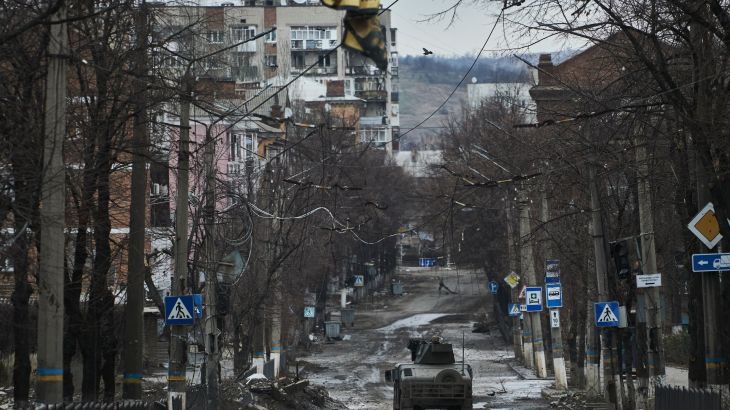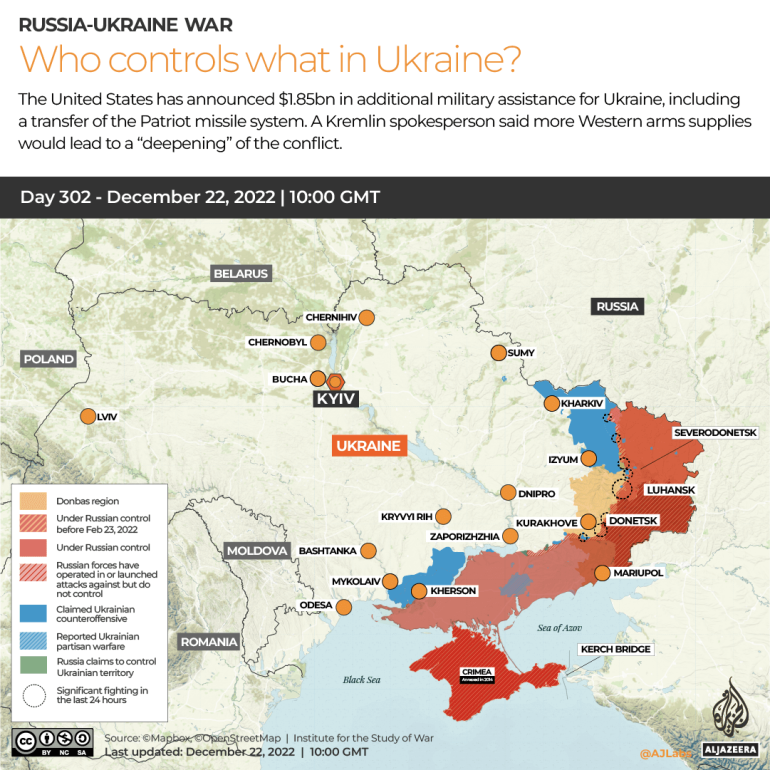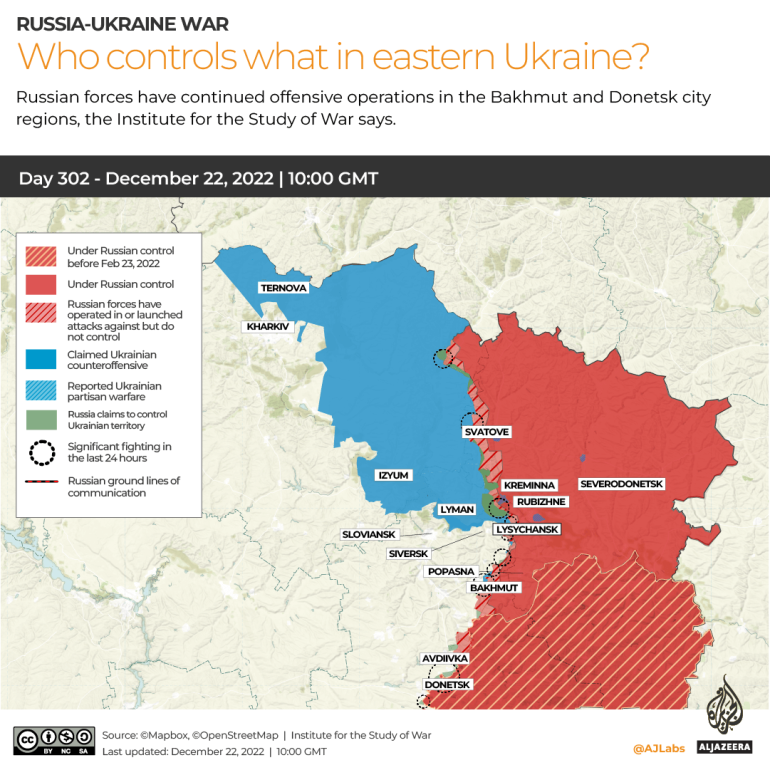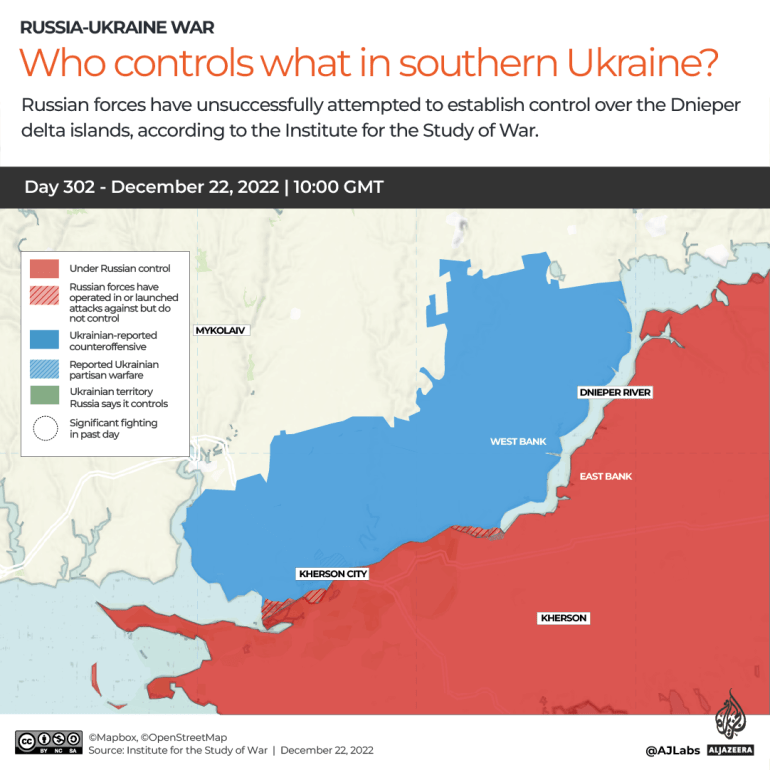Ukraine expects key offensive as Russia plans to expand army
The war is poised to escalate as Russia has planned new conscription and Ukraine’s allies have lifted weapons bans.

Russia has announced plans to form 17 new divisions and a new army corps, restoring much of the military’s former Soviet glory, as it continues to wage a relentless battle for Ukraine’s eastern territories in the 43rd week of its war.
Russian defence minister Sergei Shoigu unveiled plans on December 21 to expand the army from 1.15 million to 1.5 million, citing the imminent expansion of NATO to include Finland and Sweden. Within that force, the professional army would almost double to 695,000 – a potential admission that Russia’s conscript force has proven ineffective in the offensive.
Keep reading
list of 3 itemsUS to send $1.8bn aid to Ukraine, including Patriot system: Media
UK’s PM Sunak to announce $304m in new military aid for Ukraine
“The expansion of NATO’s forward presence close to the frontiers of the Russian Federation and the Republic of Belarus, along with the West’s intention to continue military operations in Ukraine in an effort to weaken Russia as much as possible, are of special concern,” Shoigu said.
Russia conscripted 300,000 troops in September and October to send to Ukraine, and another 200,000 in its regular conscription cycle last month. Shoigu’s announcement suggests another 350,000 would now be recruited.
The Institute for the Study of War (ISW), a Washington-based think-tank, agreed with the Ukrainian military leadership that Russia could be preparing for a big winter ground offensive – possibly against Kyiv – as a way of forcing Ukraine to negotiate on terms more favourable to Moscow.
The main Russian offensive in the east of Ukraine and its missile campaign of terror against the population “are failing to coerce Ukraine into negotiating or offering preemptive concessions”, the ISW said.

The ISW assessed that Russia does not have the economic capacity to scale up its armed forces but that could change.
“Putin can decide to appropriate Russian state funds in such a manner that allows the Kremlin to field a large conventional military at the expense of economic growth and consumer comforts as the Soviets did,” it said.
Aerial campaign
Russia has continued its psychological war against Ukraine’s civilians. Air raid sirens went off throughout the country on December 16 as Russia launched 76 missiles at critical energy infrastructure – its ninth extensive volley since launching the air campaign in early October.
Forty of the missiles were lobbed at Kyiv. Most were shot down but 16 hit their mark, causing power and water failures in several large cities, including the capital.
Two days later Ukraine’s general staff said air defences had destroyed 30 out of 35 Iranian-made Shahed drones fired into Ukrainian territory from the Sea of Azov.
Ground war
Throughout the week, Russia and Ukraine launched ground offensives in the two eastern regions of Luhansk and Donetsk.
The action was concentrated mainly in two areas – between Svatove and Kreminna in Luhansk, which lies under Russian occupation just a few kilometres behind the line of contact, and between Soledar and Bakhmut in Donetsk, which Russia imminently threatens to overrun.
On December 16, Russia said its forces repelled reconnaissance and sabotage units probing the defences of Kreminna. Three days later, Russia claimed to have destroyed four reconnaissance groups near Rozivka, likely probing Russian defences around Svatove, just 15km (9.3miles) from the front lines.

Ukraine’s General Staff said its forces were repelling Russian ground offensives on a daily basis, inflicting high casualties. “Due to the significant losses of the invaders, the repurposing of hospitals in the temporarily occupied territories of Luhansk oblast into military hospitals continues … The local population is refused service and suggested to turn to other medical institutions.”
Russia claimed to have taken up “new advantageous lines and positions” in Donetsk every day. The only verifiable territorial gain was the Russian occupation of the settlement of Yakovlivka in Donetsk on December 18.
The most intense fighting has been in and around the city of Bakhmut in Donetsk, whose eastern outskirts are now Russian-occupied.
Independent Russian newspaper Meduza published photos of daily life there, showing people living in half-bombed buildings and crossing streams on duckboards. Much of daily life reportedly takes place underground.
Ukrainian President Volodymyr Zelenskyy made a daring visit to the town on December 20, putting himself just streets away from Russian forces, and thanked soldiers “for their courage, resilience and strength”. Zelenskyy has frequently arrived unannounced at various places along the front but this was his most fearless appearance to date.
The same day, Duma deputy Andrey Gurulev said Russian President Vladimir Putin was in the zone of the so-called special military operation, without revealing where, and “spoke with all the commanders” – an apparent attempt to shore up Putin’s image as an involved military leader equal to Zelenskyy.
Putin had first attempted this on December 16, when the Kremlin said he was at the joint headquarters of the armed forces. Video analysis suggested he was on Russian soil, at the Southern District headquarters in Rostov.

A day after Bakhmut, Zelenskyy visited Washington, DC, appearing alongside US President Joe Biden, in what was his first known trip outside Ukraine since Russia’s invasion on February 24. He thanked Americans for providing military assistance and asked for more.
“We have artillery, yes, thank you. … Is it enough? Honestly, not really,” Zelenskyy told the US Congress, many of whose Republican members have expressed opposition to more spending on Ukraine. “Your money is not charity. It’s an investment in the global security and democracy that we handle in the most responsible way,” he said.
Biden had a ready response for Zelenskyy. He released the sophisticated US Patriot air defence system for use in Ukraine – something Russia’s embassy in Washington, DC warned would have “unpredictable consequences”. Congress is set to approve $45bn in new military and financial aid for Ukraine at the end of the year, in addition to the $70bn approved so far.
The relentlessness of the Russian campaign has led other NATO members to reconsider self-imposed limits on weapons deliveries to Ukraine.
The United Kingdom’s defence secretary, Ben Wallace, has said he would reconsider the UK’s refusal to supply long-range weapons if Russia continued attacks against civilians.
“I constantly review the weapons systems we could provide,” Sky News quoted Wallace as telling parliament on December 13. “We too have in our armour potential weapons systems that are longer and should the Russians continue to target civilian areas and try and break those Geneva Conventions, then I will be open-minded to see what we do next,” he said, referring to the agreed basic humanitarian principles during war.
Slovakia said on December 12 that it was prepared to send MiG-29 fighter planes to Ukraine, pending a NATO agreement. Poland has also been known to be pushing for NATO to allow it to send its MiGs.
Greece was reportedly considering sending Ukraine a battery of Russian S-300 anti-aircraft missiles currently in eastern Crete, something Russia’s foreign ministry spokeswoman Maria Zakharova said would be a “blatantly aggressive move against Russia”.
Asked whether the US would provide Greece with a Patriot air defence system to replace the S-300s, the state department’s spokesman Ned Price referred to Slovakia’s donation of S-300s to Ukraine at the start of the war. “We were able to help support and facilitate that contribution by backfilling Slovakia’s needs,” he said.
Russia, too, said it was fielding new weaponry, sending its most advanced T-90 “Breakthrough” tanks to the eastern front, without specifying how many. Moscow says the tank is its best protected and has “highly automated fire control” systems.
Putin made a trip to Minsk. He said the militaries of Russia and Belarus were carrying out “combat coordination”, stirring fears of a renewed attempt to march on Kiyv from the north. Russia launched its invasion of Ukraine from Belarusian as well as Russian territory on February 24.
Putin, who has constantly alluded to the potential use of nuclear weapons against Ukraine, also said he would continue “training the crews of combat aircraft of the Belarusian army, which have already been converted for the possible use of air-launched ammunition with a special warhead”.
Although Belarusian President Alexander Lukashenko ruled out the use of nuclear weapons from his soil in February, in August he agreed to Putin’s proposal to modify Belarusian Su-24 planes to carry nuclear warheads.
The economic war also continued apace.
European Union energy ministers on December 19 agreed on a gas price ceiling of $180 megawatt hours in the internal EU market to curb energy costs to EU governments and consumers increased by the war. The cap is to become effective beginning February 15 at the Title Transfer Facility (TTF), the main European gas hub, and March 31 in all European gas hubs.
Bloomberg news agency reported that Russian oil exports had fallen by 54 percent in the week after a Group of Seven (G7) price cap of $60 a barrel came into force while cautioning that the sample was still too small to be sure that the cap was the cause of this drop.